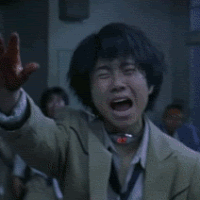
Modern day Japan is such a wacky country that it's almost difficult to believe that they were once a brutal imperialist empire. But I suppose that's the way of things. Even the Romans woke up one day to find they had turned from an empire of orderly hard-bastards to a collective of sloppy deviants (likely infested by furries, bronies, and neckbeards with love pillows), and had about 10 seconds to process this before getting it up the arse from the Goths and the Turks.
The point is that Japan is such a fun, relatively peaceful country that imagining them descending into a totalitarian regime is pretty frightening. Especially one that turns otakus into bloodthirsty monsters. Which is exactly how Koushun Takami's novel Battle Royale plays out.
In the wake of World War II Japan faces rebellion from within. The combined security forces of the nation brutally repress any resistance and form The Republic of Greater Asia - a regime which rules with absolute authority and has the fascist leanings of the average British tabloid newspaper. As part of the regime's ruthless control of the nation, they enact Battle Experiment No. 68 Program - aka Battle Royale - and every year force randomly selected classes of high-school kids to participate a bloody fight to the death. The kids are dropped onto an island filled with traps and weapons, given three days, and told there can only be one. And as the gear the kids get is randomised, it's probably not going to be the kid with the kitchen utensils.
This certainly sounds familiar, I hear you cry. Why yes, dear reader, it's the exact same plot Suzanne Collins ripped off 'without realising' when she created The Hunger Games. Although that's not being entirely fair - she did add the now obligatory idea of a single teenage girl being able to take down an all-powerful and evil government. Can you even imagine if 1984 or Brave New World were written today? They'd both end with some pansexual teenage Muslim saving the day through the power of enforced tolerance.
Fortunately, Battle Royale is fairly old school dystopia: the only way out is to play the state's murderous game. In terms of tone it's a pulpy amalgamation of Lord of the Flies, The Lottery, and The Long Walk. As is proper dystopia tradition, these guys don't mess around. They really have thought of everything - they even use exploding collars on the students to force participation. Why didn't The Running Man organisers think of that?
This is a rather explosive book which actually caused some controversy upon its original release. When you consider that just about every character who appears in the story is only around fifteen years old and is involved in a violent murder, their own or otherwise, it's not hard to see why. But the plot actually goes even further. All 42 participants of the game we get to witness are all classmates, so they're forced to pit off against their friends, crushes, and rivals. Even the friends who do team up have the knowledge they're inevitably going to have to go full Connor MacLeod. There're strategic allegiances, massacres, breakdowns, and paranoia abound.
It's a little weird that this class, living in an Orwellian regime and all, aren't really prepared for this eventuality. I mean the BR program is public knowledge, that's the whole point. A dictatorship has got to swing its dick about. That's why they're dicktators.
So when they're gassed on the way to a school trip (mine just went to Scarborough, which was more depressing) and wake up in a military installation nobody knows what's going on. This is partly for exposition reasons, but also because the average Japanese person responds to new developments with angry confusion as though someone has asked to borrow their mobile Gundam suit.
Though we're given protagonists with their own struggles to lead us through proceedings (standard wholly good boy and girl, except the boy is cool as - I think coolness is in the Japanese constitution), Takami pulls a James Herbert/The Fog and carefully stage manages the ensuing carnage. For a book that's 600+ pages, the action keeps it moving at a breakneck pace (chapters are only a few pages long). Every character in class appears at some point in the book. Even if it's just for one chapter, and that chapter is simply their brutal death. Because sweet Jesus is this book brutal:
Yoshimi Yahagi fell onto the corpse of her beloved Yoji Kuramoto and lay motionless. The .45 caliber bullet had demolished the back of her head. But her mouth remained open as if she were screaming, and blood came flowing out. It soaked Yoji's school coat, oozing out into a dark patch."
Necks are exploded, sickles embedded into skulls, eyeballs pop out, and just about every violent injury you can think of is wonderfully crafted by Takami. As the book is translated from Japanese (I read the Remastered Nathan Colins version) there's obviously stuff lost in translation and cultural differences. But the writing's functional so it doesn't matter too much, and Takami describes each death with the workman efficiency of a serial killer.
What makes the whole process more effective is that the novel throws in a bit of teen drama into the mix. You really get to feel for the characters in their individual sections - with their relationships and issues, which they have to deal with whilst not dying. As good as the 2000 film adaptation is, there's certainly less room for character development. Even the novel's two big monsters - the femme fatale Mitsuko, and triple-hard bastard Kiriyama - are given softer sides here. You know, in between wiping off all the guts from their boots.
Enjoyed this piece? Then leave a comment and share it about. Also, follow Iron on Facebook, Google Plus and Twitter to stay up to date. Stalker.


Comments
Post a Comment